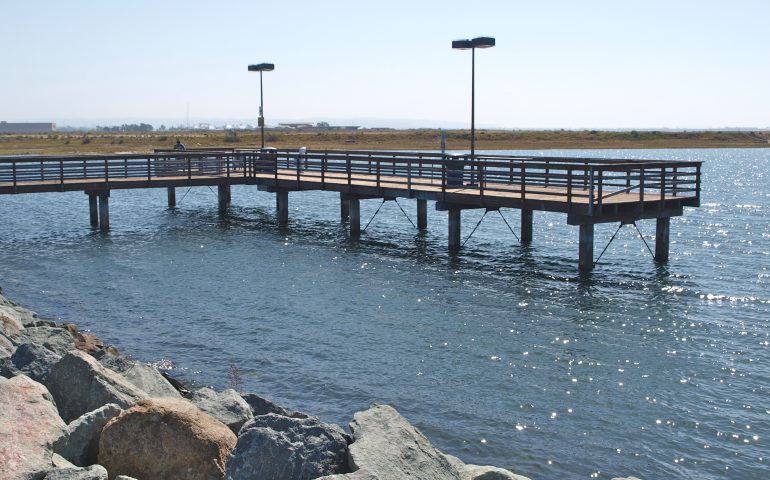Public Pier — No Fishing License Required
One day I got a letter from John Lopez, an angler who had read the first edition of Pier Fishing In California. It began, “locals call it the 24th Street Pier—you may have omitted it deliberately.” The bad news was that this wasn’t the case; I had simply missed it. The good news was that I got the chance to meet John, the Curator of Aquaria at the Chula Vista Nature Center. Not only is he an interesting person but so was the Nature Center itself, a place later renamed The Living Coast Discovery Center. Unfortunately the Center was predicted to close at the end of 2013 unless it was able to find additional funding—and prospects didn’t look bright. It’s too bad because the Center was a place that I once wholeheartedly recommended visiting.
Environment. This small pier, T-shaped and 162 feet wide at the end, is an interesting pier because of the contrasts, which it presents. The pier is situated where the Sweetwater River (and flood control channel} enters into San Diego Bay. During the rainy season (a few winter months) this can mean waters that are less salty than in other parts of the bay. The result can be a short-term decrease in the number of resident species.
However, the pier also sits adjacent to National City’s marine terminal and due to regular dredging the area offers some of the deepest near-shore waters available to pier anglers. This can mean more species and fish, especially pelagic species like mackerel.
One final piece of the puzzle is its location in the South Bay, a warmer water area that sees a few more exotic species such as Cortez bonefish and shortfin corvina.
Overall it seems to be one of those hot or cold piers, good fishing versus slow fishing, based on the time of the year, weather (especially rain and runoff from the rain), as well as the normal into the bay, out of the bay pattern of pelagic species). My experience at the pier tends to support the hot or cold variations in fish and fishing. Unfortunately my personal records show a low rating as far as fish per hour (2.33) and points per hour (4.11) that would rank the pier next to last among San Diego County piers.
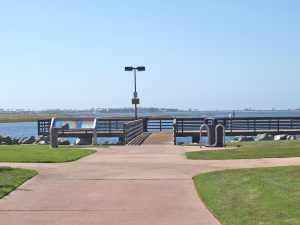
The 5½-acre park with its landscaped picnic areas, barbecue pits, sand filled playground, and grassy areas is an excellent spot to bring a family. Fix up a meal, let the kids play, and finish off the visit with some time on the pier.
The bottom here is mud and there is little growth on the pilings or the shoreline rocks (which often means poor fishing). In contrast, on the other side of the channel sits the Paradise Creek Salt Marsh Education Park and the Sweetwater Marsh National Wildlife Refuge. The 316-acre refuge represents the largest remaining salt marsh in San Diego Bay and is populated with a rich assortment of inhabitants (clams, bubble shells, horn snails, and crabs, to name just a few). Since marsh areas such as this are important for the growth of juvenile fish, and since some of these fish wind up as food for larger fish, the marsh area should serve as a fairly productive attractant of fish for anglers.
The park and pier sit down toward the south end of San Diego Bay and the pier tends to get the types of fish associated with most southern California bays. Resident, year-round species include black seaperch, white seaperch, topsmelt, jacksmelt, barred sand bass, spotted sand (bay) bass, kelp bass, some croaker, halibut, turbot, sharks, stingrays, guitarfish and bat rays.
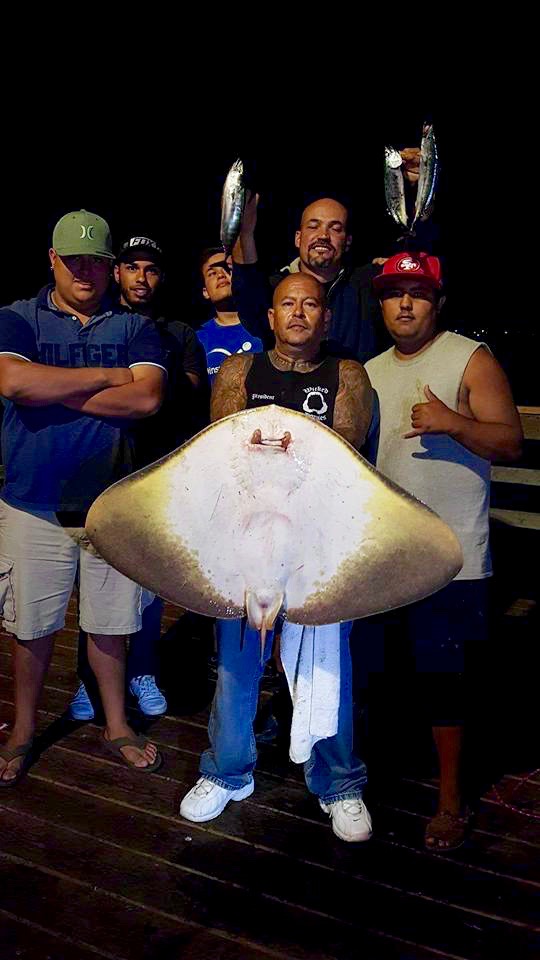
A nice-sized butterfly ray taken in September 2016.
More seasonal in nature are the pelagics, fish such as mackerel, bonito (some years) and barracuda. As mentioned it’s also a pier where you might occasionally see a Cortez bonefish (use ghost shrimp) or shortfin corvina (use live bait or artificial lures). Needlefish and mullet can also be unexpected and welcomed species. Very unusual was the capture in 2018 of a baby broomtail grouper.
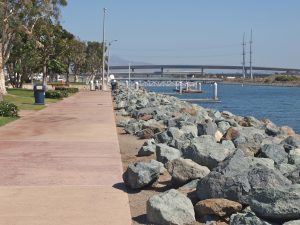
Fishing Tips. Best bet would be to fish two rods, using one to try on the bottom for resident species, and the second to try on the top for more transitory fish like mackerel and bonito. On the bottom use ghost shrimp, bloodworms, fresh mussels or clams for species such as croaker, diamond turbot and bonefish. Add anchovies to the mix when you’re seeking bass or halibut. If you want sharks and rays, try one more addition, squid, and make sure you have a little heavier line. Best results on top will come with live anchovies or small smelt, which you will need to catch yourself, or on a variety of lures. Bonito feathers trailing behind a cast-a-bubble seem to be popular for bonito, as are gold spoons and small spinners for a variety of species. Many anglers also try for bay bass using soft plastics, 3-5 inch grubs, swim baits and even spinner baits. Remember to fish the artificials around the pier itself where the bass are found.
Also remember to keep your hooks a reasonable size. Try size 8 or 6 hooks if you’re seeking perch or turbot, size 6 or 4 if you’re after croaker or bass, and size 4 or 2 if you want a halibut. Don’t be afraid to go to larger hooks and heavier size line for the sharks, guitarfish and bat rays.
This can also be a good pier to introduce kids to the joy of fishing. It is a small pier, sits near the park, and can provide some type of small fish most of the year. Staghorn sculpin on the bottom, shinerperch mid-depth, and jacksmelt and topsmelt toward the surface; all are small but generally available and all will provide excitement for the youthful angler.
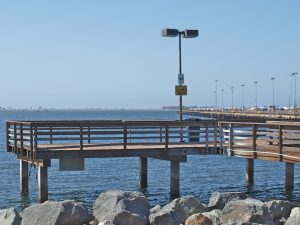
One final note regards round stingrays. A lot of these small rays are caught at local piers and they are of little use to anglers. So, return them to the water. If you’re afraid of the stinger, I recommend the following: grasp the tail by using a pair of needle nose pliers held in one hand and simply cut off the stinger using a sharp knife held in the other hand. DON’T cut off the tail! A new stinger will grow back in about a month and the fish will be none the worse for the experience. (Bat rays and stingrays which have had their stingers removed explains how it is safe for places like the Monterey Aquarium to have petting pools for these creatures. The Chula Vista Nature Center had a similar pool with little stingrays and bat rays happily swimming around, flapping their wings, and seemingly nuzzling up for attention whenever a youngster reaches down to pet the beasts.) John Lopez, by the way, got many of the stingray for his exhibits and petting pool from anglers at the local piers.
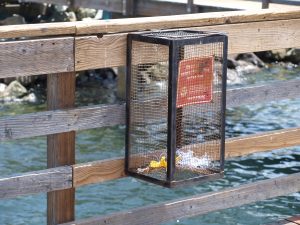
The Pier Rats Speak
Date: November 23, 1999; To: Pier Fishing in California Message Board; From: Rey; Subject: Pepper Park Pier
I usually fish Embarcadero Pier, but it has been slow lately, so I decided to try something new. I decided to fish Pepper Park Pier. I tried this pier once and that was about a year ago and all I caught was one mack. So I went to Pepper Park. After about an hour and a half, I was unable to get a bite. But some guy using frozen anchovies was consistently catching some undersized spotted bay bass. I asked him if he fishes this pier on a regular basis and he said he does. He explained to me that this is the best pier in San Diego. He explained to me about two weeks ago, he caught a 31-inch halibut using dead sardines. He also explained that there are some huge bass being caught off this pier. He says macks run on a regular basis. He says fishing is best after 6 p.m. This is probably the least fished pier in San Diego.
Posted by tackleman
I have fished it on many occasions with only the bat rays biting and a few smelt here and there. It’s definitely not the best pier in SD. I think it’s the worst to fish on—it’s too small in size and you can’t get out to the channel too well.
Date: December 10, 1999; To: PFIC Message Board; From: Rey; Subject: Pepper Park Pier
Me and my brother fished from 2:30 to 5:30 PM. We caught 4 undersized Spotted Bay Bass and 1 that was 16 inches long and weighed around 3 pounds. We used frozen Anchovies. I talked to a guy that is a regular on this pier and he said that Bass has been biting at a fair rate. He also mentioned that Halibut has been biting also.
Date: August 31, 2019; To: PFIC Message Board; From: mav; Subject: Pepper Park Pier
Did you hear about the big baby Broomtail Grouper that was caught at Pepper Park last year? I could just imagine a full-grown grouper gulping up bite-sized bonito, maybe even mullet.
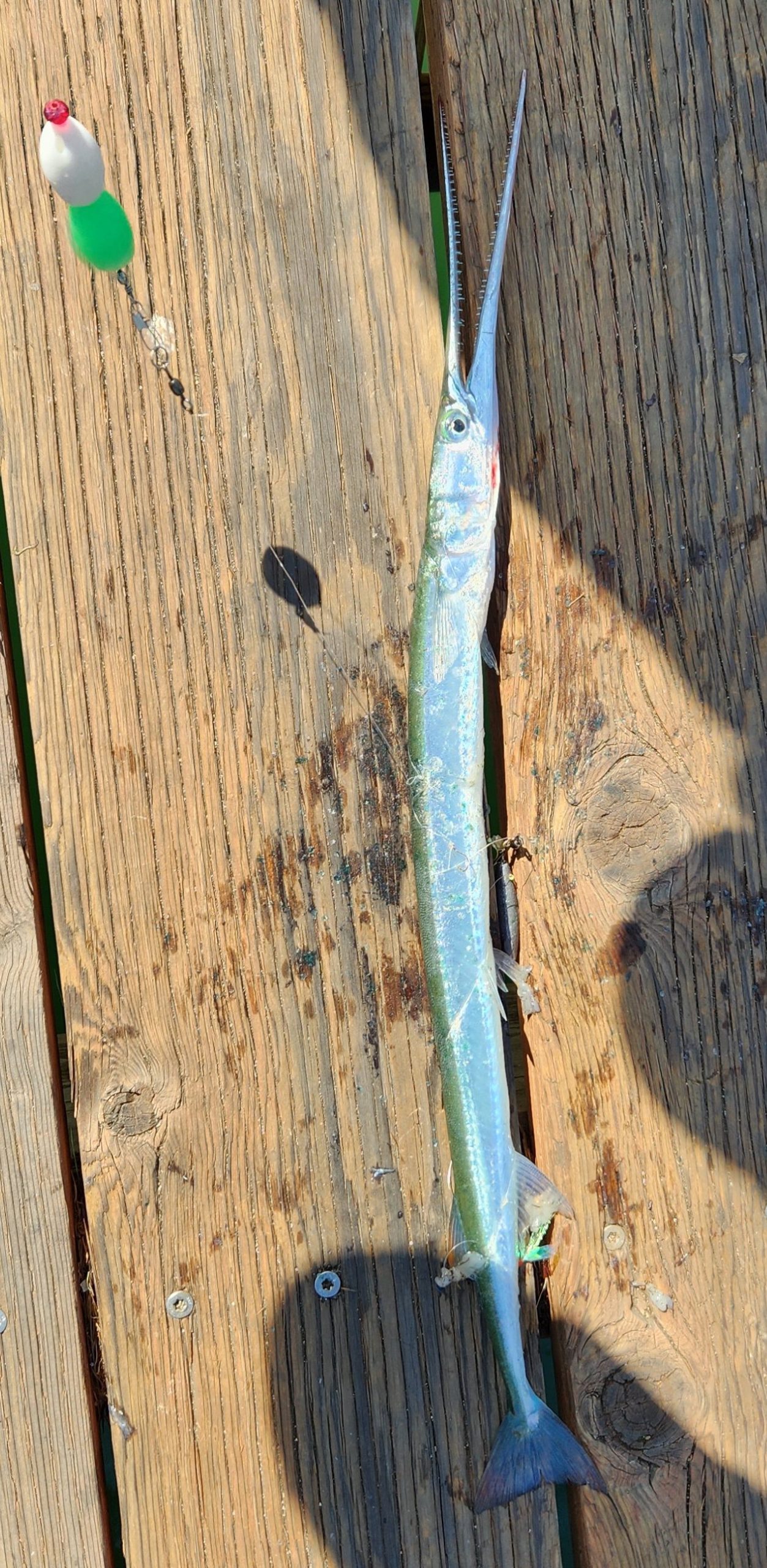
Needlefish taken in October 2022
Date: October 11, 2022; To: PFIC Message Board; From: Ray619; Subject: Pepper Park Pier
Received some Intel that Big Corvina around the pier. Brought my best surface lures. Fished today from 12pm to about 245 pm tossed everything for nothing. Only thing exciting was a big needlefish followed my Shimano waxwing lure, but it did not strike. Saw some major boils away from the pier. Saw two big mackerel caught on Sabiki rigs. One guy using shrimp caught 3 black croakers. A lady next to me caught a small needlefish. Cool looking fish.
Potpourri
<*}}}}}}}}}>< — The following derby evoked a nice mention by Ed Zieralski, one of my favorite sports and outdoors writers
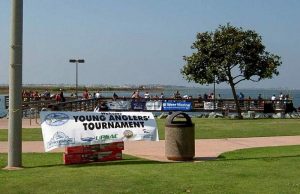
Young anglers happily hooked fishing off South Bay pier
More than a year ago, when Catherine Miller of the San Diego Sportfishing Council and officials from the International Game Fish Association organized a youth pier fishing series, they felt it would be only fair to visit different piers.
“We thought it would be great to come to these neat places in the South Bay that people aren’t aware of, places that are open seven days a week and don’t get very crowded,” Miller said during yesterday’s third and final Young Angler Fishing Tournament at Pepper Park Pier in National City.
What Miller and the IGFA didn’t envision was that the little pier fishing tournaments would be adopted by the United Pier and Shore Anglers of California (UPSAC), a group affectionately known as the “pier rats.”
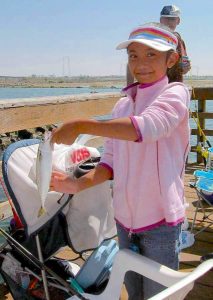
Alyssa Flores and a Pacific mackerel
The adoption by that group, spawned by the work of author Ken Jones and his book, “Pier Fishing in California,” inspired mentions of the pier fishing series on www.pierfishing.com. That led to yesterday’s amazing invasion from Los Angeles and even Northern California of both volunteers and one of the winning young anglers.
“My son and I flew here from the Bay Area on Friday just to fish this tournament,” Gilbert Orozco told Miller after his son, Thomas, 6, tied Alyssa Flores, 7, of Chula Vista, for first place. “I read about it on the pierfishing.com Web site. Now I’m going to take my boy to Legoland to celebrate.”
By winning, Thomas Orozco and Flores are eligible for next year’s IGFA Junior Angler World Championship. Gilbert Orozco said his son will go, and Jennifer Flores said her daughter, Alyssa, also will go.
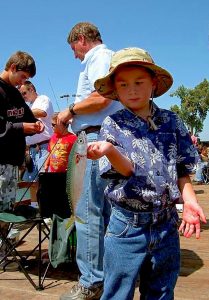
Thomas Orozco and a mackerel
Fishing was tough yesterday, except for a run of mackerel that provided some excitement. But it still was a glorious day on the pier for the 70 kids, their parents and the many volunteers Miller and crew assemble for these events.
In addition to regular volunteers such as Miller’s brother (Mark), her boyfriend (Tom Withers), Robert Watson, John Carroll of the San Diego Rod and Reel Club and John Campbell of the IGFA, the UPSAC members included Rich Reano of Chula Vista, sixth-grade teacher Ben Acker from Pasadena, Oscar Sierra of West Los Angeles, Robert Gardner and Robin Morris of the Bay area, and Ross Kestin, director of KABC-TV news in Los Angeles.
“I had a ball,” said Kestin, who, like Acker, is on the UPSAC board of directors. “To us, this is a perfect day. We’re on a fishing pier, the sun is shining and we’re helping kids fish.”
Sherrie Jancasz, teacher at Arroyo Vista Charter Elementary, had a group of 10 youngsters from her fishing club, “The Astonishing Anglers.”
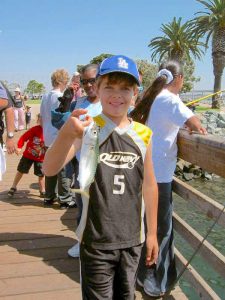
Robert “Dukie” Valderrama, new commissioner with the Unified Port of San Diego, was there with his granddaughter Alyssa Terrado, 6, who tried her luck at fishing.
“Our park here in National City isn’t the biggest, but it’s a place where people come every day to enjoy, to fish, and for some, to catch their food,” Valderrama said.
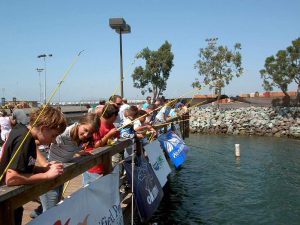
On this day the youngsters received prizes and awards like fishing trips, gift cards, lures, fishing line and more, courtesy of the many sponsors such as Squidco, which supplied 80 pounds of squid bait; West Marine; Okuma, provider of rods and reels; Maxima fishing line; Zebco, Target, Wal-Mart and sport landings such as Point Loma Sportfishing and H&M Landing.
Other age-bracket winners included: Jasmin Glaman, second in the 6-year-old division; Christopher Rouston, 7; Joey Mets, 8; Andrew Peña, 10; Victor Precidio, 11; Jake Anderson, 12; Samuel Cisneros, 13; Cory Dennis and James Thomas, both 14 (tie).
Mike Austin brought his grandson, Andrew Peña, and the youngster caught his first fish ever, a 16-inch mackerel.
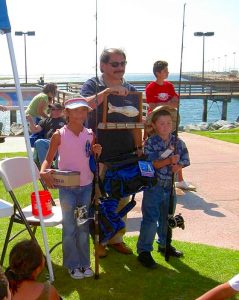
Trophies — Alyssa Flores and Thomas Orozco
“Thank you,” Austin told Catherine Miller and crew as he collected up his grandson and all his prizes. “He had a ball and caught his first fish.”
—Ed Zieralski, Outdoors, San Diego Union-Tribune, September 18, 2005
<*}}}}}}}}}>< — Watch what you eat!
Health threat seen in South Bay fish —Anglers who eat most of their catch at risk, group says.
National City—An environmental watchdog group says Latinos and Filipinos may be elevating their long-term health risk because they eat most of what they catch in south San Diego Bay.
A survey conducted last year by the Environmental Health Coalition of 109 anglers found that 61 percent eat the fish they catch from urban piers between the downtown Embarcadero and Chula Vista. Also, 25 percent said they fished four to seven times a week. Among those participating in the survey, 57 percent were Latino and 39 percent Filipino. Many of those who regularly ate their catch said they fed the fish to their children, who are more vulnerable to toxic effects.
Although anglers have five piers to chose from in San Diego Bay, more than 72 percent of those surveyed by the coalition were concentrated at Pepper Park Pier in National City, whose population is among the county’s most diverse. According to 2000 Census figures, 59 percent of the city’s residents identify themselves as Latino; nearly 20 percent say they are Asian or Pacific Islanders.
Yesterday’s release of the survey by the Environmental Health Coalition, a local group, was timed to influence state regulatory officials who in the next few months will consider sediment cleanup plans for the city’s two leading shipyards, National Steel and Shipbuilding Company, or NASSCO, and Southwest Marine. “Everyone deserves a healthy bay,” said Diane Takvorian, the coalition’s executive director. “We’re asking (regulators) to do their job.”
Sediments in the bay were contaminated with heavy metals such as copper and zinc as well as with mercury, oils and PCBs from decades of military and industrial activity. The toxins continue to accumulate in the food chain, affecting the fish consumed by wildlife and sport fishers. The San Diego Regional Water Quality Control Board has attempted to control pollutants from entering the bay since 1985. The state agency is charged with identifying those responsible for the contaminated sediments and ordering cleanup. So far, $25 million in public and private money has been spent to study the problem and clean up eight sites.
The health coalition’s survey addressed some areas not covered by a 1990 county Health Department study assessing the health risk of eating fish from San Diego Bay. Among those surveyed by the coalition, 13 percent said they ate the skin of the fish they caught from the bay, a practice that could expose them to more contaminants than if they ate only the fillets.
The $309,000 study concluded that eating bay fish poses risks for children under 6, pregnant women, infants of mothers who are breast-feeding, people who eat the entire fish, and those who eat fish daily over a long period.
The risk of cancer and mercury poisoning was found to be relatively low from most fish species, except for mercury in stingrays and PCBs in Pacific mackerel. In response to the 1990 study, the county Health Department posted a dozen sites along the bay with warnings advising people to limit their consumption of locally caught fish. The signs were printed in English, Spanish and Vietnamese, but not Tagalog, the language used by many Filipinos. The agency responsible for issuing warnings on fish consumption, the state Office of Health Hazard Assessment, has never issued an advisory for fish from San Diego Bay…
Officials for the Port of San Diego, who operate the fishing piers in San Diego Bay, said they had not seen the survey and could not comment on its findings. Gary Erbeck, the county’s environmental health director, said he also had not seen the survey but he applauded the effort to keep consumers informed. People who eat fish from the bay should limit their consumption to no more than 8 ounces per week, an amount set for all sport-caught fish in the state, he said. “I’m a big advocate of people knowing what they are eating,” he said.
—Terry Rodgers. San Diego Union-Tribune, March 5, 2005
History Note. Although originally known by the Spaniards as Rancho del Rey, the area was renamed Rancho de la Nacion in the 1820s. From this came the name National City that was adopted by the Kimball brothers, the men who began to develop the area as a city in 1868. They built the area’s first wharf, subdivided land adjacent to the bay, and sought to make National City the western terminus for a railroad. They also worked to make National City the leading city in the area. However, both their wharf, and their city, lost out in the battle with San Diego.
Kimball’s Wharf would have been located just on the other side of the Twenty-fourth Street Terminal, the huge terminal that adjoins this small pier.
Pepper Park, named after National City civic leader Leonard Pepper, is a 5.5-acre park that includes picnic areas, a boat ramp and this pier. The pier, originally built in 1970, was repaired in 1988 and today is like new
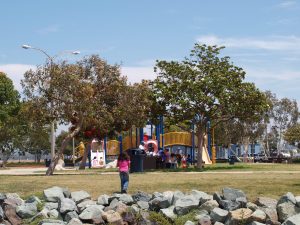
L.M. “Pep” Pepper Park Pier Facts
Hours: Open 6:00 A.M. -10:30 P.M.
Facilities: Lights and a fish cleaning station are located on the pier; restrooms and free parking is found adjacent to the pier.
Handicapped Facilities: Restrooms (not marked), ramps and curb cuts.
Location: X33.654959222951774 N. Latitude, 118.004150390625 W. Longitude
How To Get There: From I-5 take the 24th Street off-ramp west to Tidelands Avenue and go left (south) on Tidelands to the end.
Management: San Diego Unified Port District.
